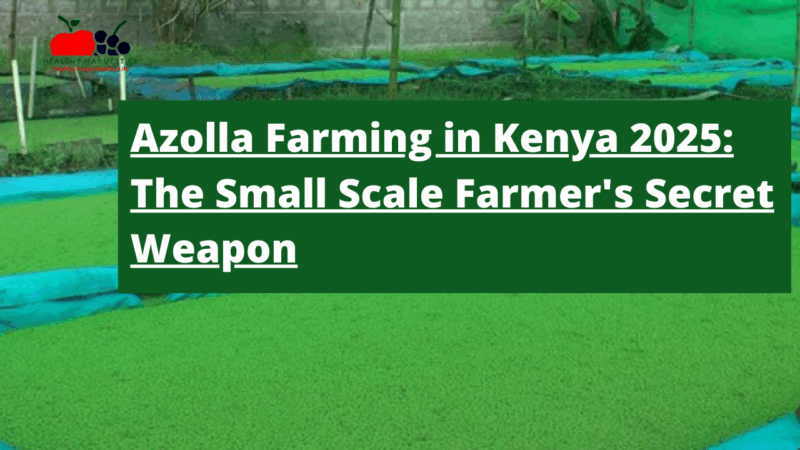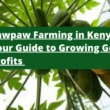Ever heard of a plant that doubles its size every week, costs almost nothing to grow, and can slash your feed costs in half? That’s azolla for you – nature’s gift to small farmers looking to boost profits without breaking the bank.
Azolla farming is quickly catching on across Kenya, and for good reason. This floating water fern is changing the game for farmers who’ve discovered its benefits. Let’s dive into why this humble plant might be your farm’s next game-changer.
What is Azolla and Why Should You Care?
Azolla is a floating aquatic fern that forms a symbiotic relationship with a nitrogen-fixing blue-green algae called Anabaena azollae. This partnership is what makes azolla special – it can convert atmospheric nitrogen into forms your crops and animals can use.
Think of azolla as a tiny floating factory that:
- Produces protein-rich feed for your livestock
- Creates free fertilizer for your crops
- Grows ridiculously fast
- Requires minimal investment
In Kenya, two main species thrive in our climate:
- Azolla filiculoides – Found in Mwea, Taveta, and TARDA regions
- Azolla nilotica – Common in TARDA and Taveta areas
The best part? Under ideal conditions in Kenya, azolla can double its biomass every 4-6 days. This rapid growth means regular harvests and consistent benefits for your farm.
Why Small Farmers in Kenya Are Turning to Azolla
Let’s be real – farming in Kenya isn’t getting cheaper. Feed costs are climbing, fertilizer prices are through the roof, and unpredictable weather makes everything harder.
This is where azolla comes in clutch:
Slash Your Feed Costs
Commercial feeds are eating into your profits. Azolla contains 20-30% protein, plus essential amino acids, vitamins, and minerals your animals need.
Many Kenyan farmers report cutting their feed costs by 30-50% by supplementing with azolla. For a small farmer with just 100 chickens, that could mean savings of KSh 3,000-5,000 per month.
Ditch Expensive Fertilizers
Why buy nitrogen fertilizers when you can grow them? Azolla works as a bio-fertilizer that slowly releases nutrients as it decomposes.
Research in Mwea shows that adding azolla at 7.5 tons per hectare during rice transplanting significantly boosts grain yield. The timing matters – applying azolla at transplanting works better than waiting until 21 days after.
Perfect for Limited Space
Don’t have acres of land? No problem. You can start azolla farming in containers as small as a plastic basin. Even a 2×2 meter pond can produce enough azolla to supplement feed for a small flock of chickens.
Setting Up Your Azolla Farm: Simpler Than You Think
You don’t need fancy equipment or a degree in agriculture to start growing azolla. Here’s how to get your farm up and running:
Step 1: Choose the Right Spot
Look for a location that has:
- Access to water
- Good drainage
- Some shade during the hottest part of the day
- Protection from strong winds
Step 2: Create Your Growing Area
You’ve got options here, depending on your budget:
Budget Option: Use plastic sheets to line a shallow pit (10-20cm deep).
Mid-Range Option: Repurpose old containers, plastic tubs, or kiddie pools.
Permanent Setup: Build a cement pond with proper drainage.
Whichever option you choose, aim for a water depth of 10-20cm – deep enough to prevent drying out but shallow enough for easy harvesting.
Step 3: Prepare the Water
Fill your container or pond with clean water and let it sit for a day to reach ambient temperature. Test the pH – azolla likes it slightly acidic to neutral (5.0-7.0).
Add a thin layer of cow dung or compost to provide initial nutrients. About 1kg of composted manure per square meter of water surface does the trick.
Step 4: Get Your Starter Culture
You’ll need some azolla to get started. Check with:
- Local agricultural extension offices
- Farmers already growing azolla
- Agricultural research institutions
About 500-1000 grams per square meter of water surface is enough to start. Spread it evenly across the water.
Step 5: Maintain and Watch It Grow
Once established, azolla farming is surprisingly low-maintenance:
- Add fresh water to replace what evaporates
- Apply diluted manure or compost tea every 10-15 days
- Harvest regularly to prevent overcrowding
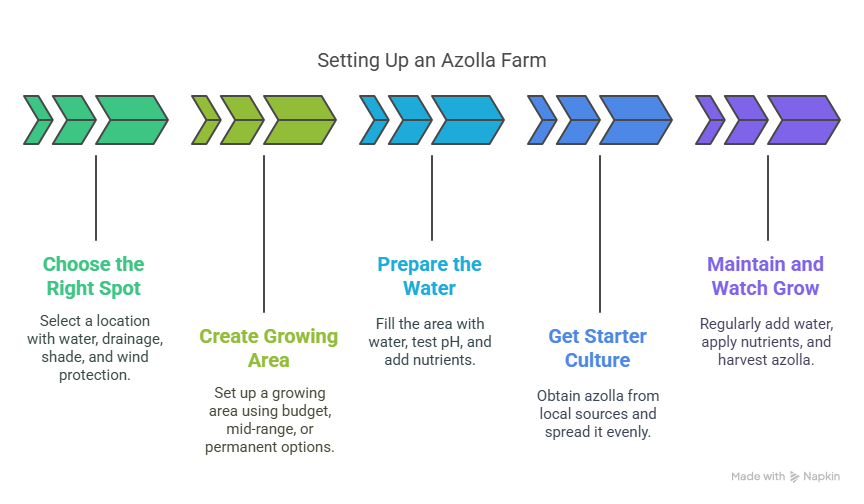
The Harvesting Hustle: When and How
Timing is everything with azolla harvesting. Wait until it covers about 80% of the water surface – usually every 5-7 days in warm Kenyan conditions.
To harvest:
- Use a fine-mesh net or sieve to scoop out the azolla
- Leave about 20-30% behind to continue growing
- Let excess water drain for 15-20 minutes
- Use fresh or process for storage
A 10 square meter azolla pond can produce about 1-2kg of fresh azolla daily – that’s 30-60kg per month from a tiny space!
Putting Azolla to Work on Your Farm
Now for the fun part – putting this superfood to work on your farm:
For Your Livestock
Azolla makes an excellent feed supplement for nearly all farm animals:
Chickens: Mix fresh or dried azolla with commercial feed at a 15-20% ratio. Farmers report improved egg production and meat quality.
Fish: Azolla is a perfect supplement for tilapia. Simply add fresh azolla directly to fish ponds – the fish will feed on it as needed.
Dairy Cows: Add 2-3kg of fresh azolla to daily feed rations to boost milk production. Some Kenyan dairy farmers report 10-15% increases in milk yield.
Pigs: Mix azolla with regular feed at a 10-20% ratio to reduce costs without affecting growth rates.
For Your Crops
Azolla’s benefits extend well beyond animal feed:
Rice Fields: Azolla and rice are perfect partners. Research shows incorporating azolla into rice paddies can provide up to 60kg of nitrogen per hectare – the equivalent of about 2 bags of CAN fertilizer.
Vegetable Gardens: Use composted azolla as a top dressing for vegetables. It breaks down quickly, releasing nutrients precisely when plants need them.
Fruit Trees: Apply composted azolla around the base of fruit trees to improve soil structure and provide slow-release nutrients.
Real Talk: Challenges You Might Face
Let’s be honest – azolla farming isn’t without challenges:
Managing Explosive Growth
Azolla grows fast – really fast. Without regular harvesting, it can form thick mats up to 30cm deep that block light and reduce oxygen in the water. The solution? Harvest regularly and maintain appropriate density.
Water Management
You’ll need to keep a close eye on:
- pH levels (aim for 5.0-7.0)
- Water temperature (ideal range is 20-30°C)
- Nutrient availability
During hot, dry periods, you might need to add water more frequently or provide some shade.
Pests and Diseases
While generally hardy, azolla can face issues with:
- Fungal infections in overly humid conditions
- Insect damage (especially from caterpillars)
- Competition from other aquatic plants
Regular monitoring and maintaining good water quality will prevent most problems.
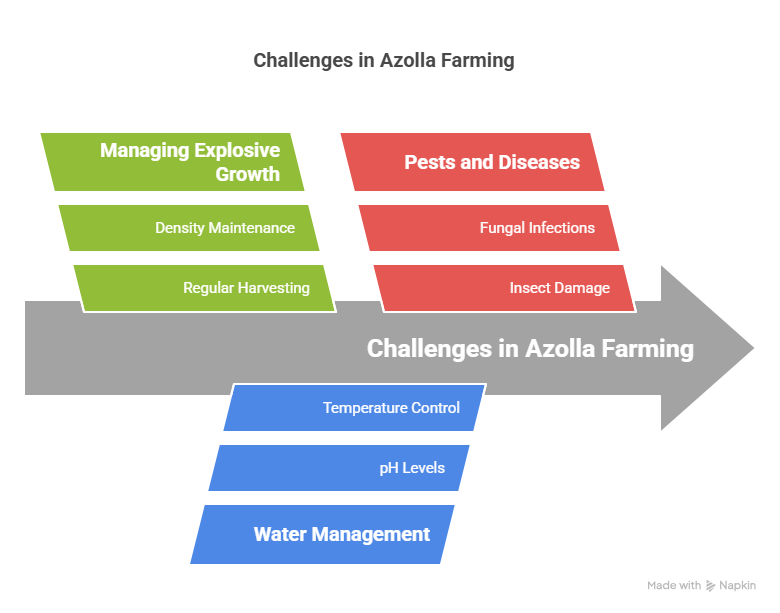
Beyond the Basics: Advanced Azolla Applications
Ready to take your azolla farming to the next level? Consider these innovative approaches:
Integrated Farming Systems
Some forward-thinking Kenyan farmers are implementing rice-azolla-duck-fish systems where:
- Azolla provides nitrogen for rice
- Ducks eat azolla and insects
- Duck waste fertilizes water for fish
- Fish waste provides nutrients for azolla
These systems maximize productivity from a single water body.
Climate Change Buffer
Azolla helps capture carbon dioxide and can reduce methane emissions from rice paddies. In a world of changing climate, azolla provides some resilience for small farms.
Value-Added Products
Some entrepreneurial farmers are drying and processing azolla into pellets or powder for sale to other farmers – turning a free resource into an income stream.
Getting Started: Your First Month Plan
Here’s a simple timeline to get your azolla farm up and running:
Week 1: Set up your pond or containers and prepare water.
Week 2: Introduce starter culture and monitor growth.
Week 3: First harvest and begin feeding to animals or applying to crops.
Week 4: Establish regular harvesting schedule and begin expanding as needed.
The initial investment for a small setup (10 square meters) is typically under KSh 5,000, including plastic lining, simple tools, and starter culture. Many farmers recoup this investment within 2-3 months through feed savings alone.
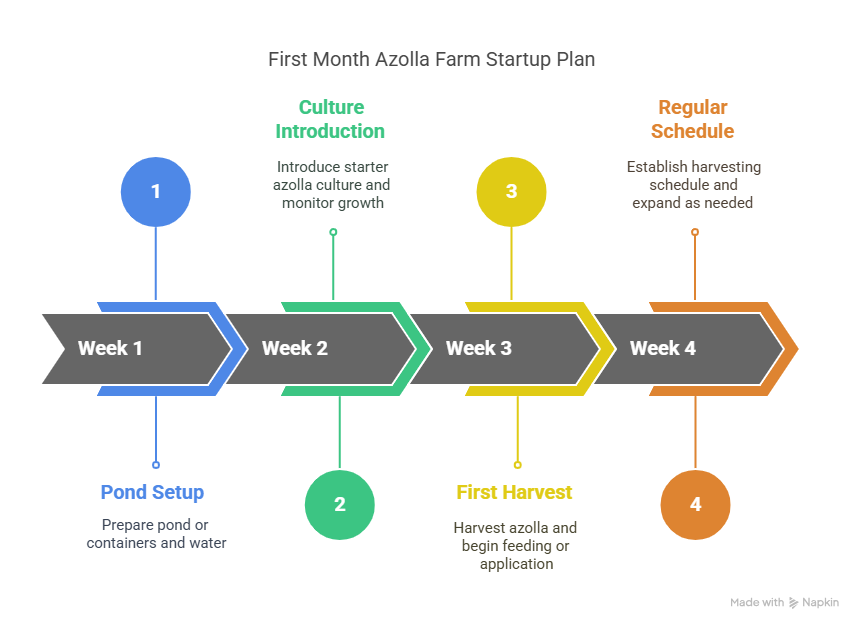
Small Plant, Big Impact
Azolla farming might not be as flashy as some modern agricultural technologies, but its impact on your farm’s bottom line can be profound. For small-scale farmers facing rising costs and climate uncertainty, this ancient plant offers a practical solution that’s accessible, affordable, and effective.
Whether you’re raising chickens in your backyard or managing a small mixed farm, azolla deserves a place in your farming toolkit. Start small, learn as you go, and watch as this tiny fern makes a big difference to your farming success.
Ready to get started with azolla farming? Reach out to your local agricultural extension office for specific guidance tailored to your area’s conditions.
Frequently Asked Questions
How much space do I need to start azolla farming?
You can start with as little as a plastic basin or a 1×1 meter pond. Even this small space can produce enough azolla to supplement feed for a small flock of chickens.
How much does it cost to set up an azolla farm?
For a basic 10 square meter setup, expect to spend KSh 3,000-5,000 for plastic lining, simple harvesting tools, and starter culture. More permanent setups with cement ponds will cost more but last longer.
Where can I get azolla to start my farm?
Contact your local agricultural extension officer, agricultural research institutions, or connect with farmers who are already growing azolla. Sometimes agricultural colleges and universities also maintain azolla cultures.
How do I store azolla if I harvest more than I need?
Fresh azolla can be stored for 2-3 days in a cool place. For longer storage, dry it in the shade (not direct sun) until crisp, then store in airtight containers. Properly dried azolla can be stored for several months.
Can azolla completely replace commercial feeds?
While azolla is nutritious, it’s best used as a supplement rather than a complete replacement. For most livestock, replacing 15-30% of commercial feed with azolla provides good results without compromising performance.
Is azolla farming legal in Kenya?
Yes, azolla farming is legal and increasingly promoted by agricultural extension services as a sustainable farming practice. However, be careful not to introduce azolla into natural waterways where it can become invasive.
How do I prevent azolla from becoming invasive?
Contain your azolla in dedicated ponds or containers, harvest regularly, and never dispose of excess azolla in natural waterways. If you need to dispose of azolla, compost it or use it as mulch in your garden.
Can I sell the azolla I produce?
Yes! There’s a growing market for azolla among livestock farmers. You can sell fresh azolla locally or process it (dry and grind) for easier transport and longer shelf life.
Does azolla work in all parts of Kenya?
Azolla grows best in areas with temperatures between 20-30°C. It can be grown throughout much of Kenya, though farmers in very hot or very cool regions may need to provide some climate control (shade or protection from cold).
How do I know if my azolla is healthy?
Healthy azolla is bright green to reddish (depending on sunlight exposure) and forms a dense mat on the water surface. Unhealthy azolla turns brown or yellow and may start to break apart.




